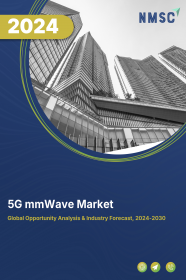
5G mmWave Market by Component (Hardware, Solution, and Services), by Bandwidth (23GHz to 57 GHz, 57 GHz to 95GHz, and 95 GHz to 300 GHz), by Application (Real-time Surveillance Cameras, AR/VR, Industry 4.0, Live Streaming, Transport Connectivity, Ultra High-definition Video, and Others), and by End-User (Aerospace and Defence, Telecom, Media & Entertainment, Automotive & Transport, Public Safety, Healthcare & Life Science, and Others)- Global Opportunity Analysis and Industry Forecast 2024-2030
US Tariff Impact on 5G mmWave Market
Trump Tariffs Are Reshaping Global Business
Market Definition
The 5G mmWave Market size was valued at USD 2.94 billion in 2023 and is predicted to reach USD 7.59 billion by 2030 with a CAGR of 14.5% from 2024-2030.
5G mmWave is a high-frequency wave technology used in 5G telecommunications networks. It uses very short radio waves in the millimetre wave (mmWave) spectrum to send large amounts of data at high speeds. This allows for more bandwidth and faster connection speeds with higher frequencies used by 5G mmWave also enable larger data capacities, lower latency, and enhanced reliability 5G mmWave operates in extremely high-frequency range of 30GHz to 300GHz that is much higher than the frequency range currently used in 4G mobile networks, and as such, 5G mmWave can support much higher data rates and throughputs. 5G mmWave plays a crucial role in delivering the ultra-fast data speeds promised by 5G, particularly for applications including augmented reality, virtual reality, and high-definition video streaming that require substantial bandwidth.
Market Dynamics and Trends
The growing penetration and increasing use of connected devices, such as smartphones, tablets, and wearables, are also contributing to the growth of the 5G mmWave market. As per the latest report published by the International Telecommunication Union, about 5.3 billion people in the world use internet in 2022.
As the number of internet users continues to surge, there is a growing demand for high-speed connectivity and efficient data transmission. The 5G mmWave technology addresses this need by offering high-speed internet services and efficient data transmission capabilities, making it possible for users to experience enhanced internet performance.
This heightened demand for improved connectivity, coupled with the capabilities of 5G mmWave technology, is driving the significant growth of the market.
Moreover, the growing penetration and increasing use of connected devices, such as smartphones, tablets, and wearables, are also contributing to the growth of the 5G mmWave market.
According to the latest report published by the GSM Association, over 7 billion people globally own smartphones in 2024. The report further anticipates that smartphone adoption is poised to reach 90% by the year 2029. This widespread adoption of smartphones underscores the increasing reliance on mobile devices for various purposes, including communication, information access, and entertainment.
As the smartphone user base continues to expand, the demand for robust and high-speed connectivity, particularly facilitated by 5G mmWave technology, is further anticipated to rise, further boosting the growth of the market.
Furthermore, the increasing demand for high-speed and low-latency services in the industrial sector is a key driver for the growth of the 5G mmWave market. Industries are increasingly relying on advanced connectivity solutions to enhance their operational efficiency and responsiveness. 5G mmWave technology, with its superior data speed and low latency, is gaining popularity among industrial users who require a reliable and fast connection for their critical operations. This technology empowers industries to deploy smart and connected systems, enabling real-time monitoring, control, and communication, thus contributing to the overall growth of the 5G mmWave market.
However, the limited range of high-frequency signals used by mmWave systems and its harmful impact on health are the major factors restraining the growth of the 5G mmWave market. On the contrary, 5G is expected to evolve to 5G NR (New Radio) standards, which will bring even higher data rates, lower latency and power consumption, and support for more devices. Additionally, the integration of 5G with other technologies such as edge computing and artificial intelligence (AI) is expected to further enhance the capabilities of 5G networks, creating numerous growth opportunities in the forecasted years.
Market Segmentations and Scope of the Study
The 5G mmWave market share is segmented on the basis of component, bandwidth, application, end-user, and region. On the basis of component, the market is divided into hardware, solution, and services. On the basis of bandwidth, the market is classified into 23GHz to 57 GHz, 57 GHz to 95GHz, and 95 GHz to 300 GHz. On the basis of application, the market is segmented into real-time surveillance cameras, AR/VR, industry 4.0, live streaming, transport connectivity, ultra-high-definition video, and others. On the basis of end-user, the market is divided into aerospace and defence, telecom, media & entertainment, automotive & transport, public safety, healthcare & life science, and others. Regional breakdown and analysis of each of the aforesaid segments include regions comprising of North America, Europe, Asia-Pacific, and RoW.
Geographical Analysis
North America holds the lion share of the 5G mmWave market and is expected to continue its dominance during the forecast period. This is attributed to factors such as the growing government initiatives for the expansion of 5G connectivity in countries such as the US, Mexico, and Canada.
As per the latest report published by the U.S. Department of Commerce, the U.S. government announced to the Public Wireless Supply Chain Innovation Fund, allocating a substantial investment of USD 1.5 billion. This initiative is designed to accelerate the future of 5G and next-gen wireless technology in the country.
Moreover, the presence of key players such as AT&T Inc, Qualcomm, and Advanced Micro Devices Inc. (AMD) plays a major role in the development of the 5G mmWave market in this region. These industry leaders play a pivotal role in driving innovation, setting technological standards, and contributing to the overall advancement of 5G mmWave technology in this region.
For instance, in March 2022, AT&T announced the launch of a 5G mmWave service in Boston, US. Through this, the company aims to offer high-speed and low-latency internet connectivity across the U.S., boosting the overall growth of the 5G mmWave market.
On the other hand, Asia Pacific is expected to show a steady rise in the 5G mmWave market. This is due to the increasing investment in digitalisation network by both public and private sectors of emerging economies such as China, India, and Japan.
For instance, in August 2022, China Mobile invested USD 8.7 billion in the development of 5G as the number of 5G subscribers reached 263 million in China in 2022. This collective drive toward enhancing digital connectivity and accommodating the escalating demand for 5G services in this region is driving the growth of the market in this region.
The increasing penetration of smartphones, coupled with the rising demand for high-speed connectivity for data transmission, is playing a significant role in driving the growth of the 5G mmWave market in the Asia Pacific region.
As per the latest report published by the GSM Association, smartphone adoption in Asia Pacific is anticipated to increase from 76% in 2022 to an impressive 94% in 2030. Additionally, the adoption of 5G technology is poised for substantial growth, projected to rise from 4% in 2022 to a substantial 41% by 2030. This shift in smartphones and 5G connectivity in Asia Pacific is driving the growth of the 5G mmWave market in this region.
Competitive Landscape
Various market players operating in the 5G mmWave market NXP Semiconductors,Airspan Networks,Fastweb S.p.A.,Corning Inc.,Nokia Corporation,Huawei Technologies Co. Ltd.,Qualcomm,Siklu Communication Ltd.,L3Harris Technologies, Inc.,NEC Corporation, and others. These market players are adopting various strategies such as product launches and collaborations to remain dominant in the 5G mmWave market.
For instance, in November 2022, MediaTek launched the T800 chipset for Industrial Internet of Things (IIoT), Machine-to-Machine (M2M), and always-connected PCs for both sub-6GHz and 5G mmWave networks. The new 5G chipset solution allows end users to enjoy high-speed, low-latency 5G.
Moreover, in November 2022, Qualcomm collaborated with Ericsson and Telkomsel to launch a Fixed Wireless Access (FWA) service using 5G mmwave extended-range technology in Indonesia. The collaboration was aimed at offering high-speed internet access and accelerating national digital transformation.
Furthermore, in October 2022, Nokia collaborated with NBN Co, a fixed wireless network provider in Australia, to supply 5G fixed wireless access (FWA) mmWave Customer Premises Equipment (CPE). The collaboration was aimed at providing faster internet and transmission speeds to homes and businesses across semi-rural, regional and remote Australia.
Key Benefits
-
The report provides quantitative analysis and estimations of 5G mmWave market from 2024 to 2030, which assists in identifying the prevailing market opportunities.
-
The study comprises a deep dive analysis of the 5G mmWave market including the current and future trends to depict prevalent investment pockets in the market.
-
Information related to key drivers, restraints, and opportunities and their impact on the 5G mmWave market is provided in the report.
-
Competitive analysis of the players, along with their market share is provided in the report.
-
SWOT analysis and Porters Five Forces model is elaborated in the study.
-
Value chain analysis in the market study provides a clear picture of roles of stakeholders.
Key Market Segments
By Component
-
Hardware
-
Solution
-
Services
By Bandwidth
-
23GHz to 57 GHz
-
57 GHz to 95GHz
-
95 GHz to 300 GHz
By Application
-
Real-time Surveillance Cameras
-
AR/VR
-
Industry 4.0
-
Live Streaming
-
Transport Connectivity
-
Ultra-High-definition Video
-
Others
By End-User
-
Aerospace & Defence
-
Telecom
-
Media & Entertainment
-
Automotive & Transport
-
Public Safety
-
Healthcare & Life Science
-
Others
By Region
-
North America
-
The U.S.
-
Canada
-
Mexico
-
-
Europe
-
The UK
-
Germany
-
France
-
Italy
-
Spain
-
Denmark
-
Netherlands
-
Finland
-
Sweden
-
Norway
-
Russia
-
Rest of Europe
-
-
Asia Pacific
-
China
-
Japan
-
India
-
South Korea
-
Australia
-
Indonesia
-
Singapore
-
Taiwan
-
Thailand
-
Rest of Asia Pacific
-
-
RoW
-
Latin America
-
Middle East
-
Africa
-
Key Market Players:
-
NXP Semiconductors
-
Airspan Networks
-
Fastweb S.p.A.
-
Corning Inc.
-
Nokia Corporation
-
Huawei Technologies Co. Ltd.
-
Qualcomm
-
Siklu Communication Ltd.
-
L3Harris Technologies, Inc.
-
NEC Corporation
REPORT SCOPE AND SEGMENTATION:
|
Parameters |
Details |
|
Market Size in 2023 |
USD 2.94 Billion |
|
Revenue Forecast in 2030 |
USD 7.59 Billion |
|
Growth Rate |
CAGR of 14.5% from 2024 to 2030 |
|
Analysis Period |
2023–2030 |
|
Base Year Considered |
2023 |
|
Forecast Period |
2024–2030 |
|
Market Size Estimation |
Billion (USD) |
|
Growth Factors |
|
|
Countries Covered |
28 |
|
Companies Profiled |
15 |
|
Market Share |
Available for 10 companies |
|
Customization Scope |
Free customization (equivalent up to 80 working hours of analysts) after purchase. Addition or alteration to country, regional, and segment scope. |
|
Pricing and Purchase Options |
Avail customized purchase options to meet your exact research needs. |

















 Speak to Our Analyst
Speak to Our Analyst




















